I must admit, I’m guilty…..I adore Xiao Long Bao, those wonderful Shanghai style soup dumplings. So here’s an batch of Xiao Long Bao:
Believe it or not, it’s from our kitchen. A few weeks ago, I planted a little seed in the Missus’s mind. One of the sites that I visit quite often is eatingchinese.org, and Gary Soup does an excellent job of finding interesting links and articles on Chinese food. On the site is a link to a Xiao Long Bao Tutorial. I mentioned this to the Missus, who immediately said "uh-uh, no way, don’t know nothin’ about making Xiao Long Bao." But understanding that "dough" and "dumplings" are so basically entrenched in the Missus’s fate, a few weeks later she asked me to print out the Xiao Long Bao recipe….and we were on our way.
So what follows is a very "broad" interpretation of that recipe. There are other recipes out there, but we decided to use the Chinese recipe as a guide. Again, it was just a guide. I’ll be documenting what we did, and what the results were. It was quite "interesting".
There are many variations on the "soup" for soup dumplings. Some use chicken feet, pork "skin",  or other items. We chose Pig’s feet. There was also an item in the recipe to "congeal" the soup. The Missus didn’t quite know what it was, but later with some help, we determined it was Agar-agar.
or other items. We chose Pig’s feet. There was also an item in the recipe to "congeal" the soup. The Missus didn’t quite know what it was, but later with some help, we determined it was Agar-agar.
So on Friday we made "aspic".
Pig’s Feet (Hock) Aspic:
2 Pork Hock/Leg(Pig’s Feet)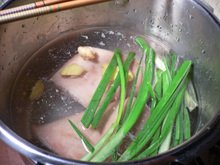
8 Cups Water
4 Stalks Green Onion(bruised and roots removed)
2 3" Fingers of Ginger Smashed
1/2 Cup Shaoxing (Chinese cooking wine)
White Pepper
Salt
2 Tb Agar Agar
1 – Set a pot of water to boil.
2 – Once boiling, place pig’s feet quickly in the water for 10-15 seconds to allow removal of "scum" on pigs feet.
3 – Rinse and scrub well.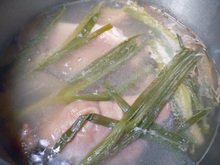
4 – Place in pressure cooker and cover with water. In this case 8 cups.
5 – Add greens onions, ginger, Shaoxing, and white pepper to liquid.
6 – Close pressure cooker and bring to "high heat", once high heat is attained, lower temp to maintain high pressure for 45 minutes.(Approx a two hour simmer on a conventional stove) After 45 minutes let the pressure drop normally for 15 minutes, then quick-release pressure. The meat should just fall away from the bone.
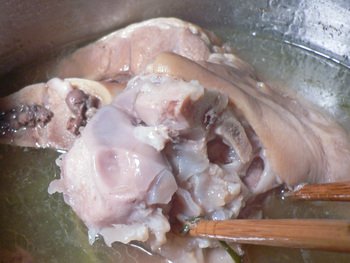
7 – Remove all large remaining portions of pork then strain.
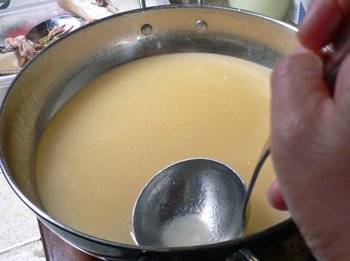
8 – Place broth into a large pot or "wok" and defat. Bring broth to a simmer and add agar-agar. To add agar-agar first get a ladle of broth and add agar powder and start mixing. Slowly lower agar into broth and gently mix until fully incorporated(no "glops" or lumps).
9 – Remove from heat.
10 – Cool, then cover and refrigerate.
Day 2:
So now you’ve woken and are totally "psyched" about making some Xiao Long Bao!
So while the Missus was making the "dough", I made the Ginger-Scallion Water from the recipe.
Ginger Scallion Water: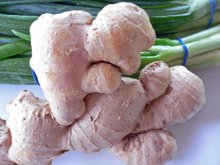
5 Stalks Green Onion
2 4" pieces of ginger chopped into 1/2" slices
2 Cups Water
1 – Placed ingredients in blender.
2 – Pulse until all ingredients are "chopped"
3 – Strain and place water aside.
The dough? Well, I’m sorry, but the Missus does it all by "feel". What she can tell me is that according to the instructions, she used a combination of high-gluten flour and all-purpose flour, along with cold water. She then kneaded until it formed a "dough" and no longer stuck to your hand. Then allow the dough to rest for 20 minutes.
While the dough was resting we made the filling:
The Filling:
1 Lb of Ground Pork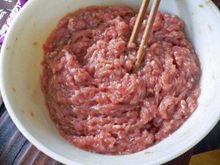
3 Tsp Salt
6 Tsp Sugar
4 Tsp Soy Sauce
White Pepper
Ginger Scallion Water
1 Tsp Sesame Oil
Aspic
1 Egg Yolk
1 – Combine Ground Pork, Pepper, Salt and Sugar (twice the amount of sugar then salt), and Soy Sauce.
2 – Stir Pork mixture in one direction while adding Ginger Scallion water until the filling is saturated and achieves a "pasty" texture.
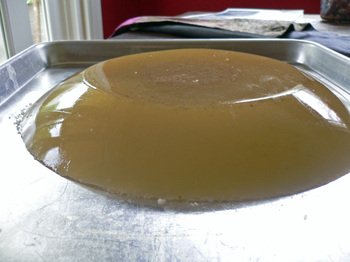
3 – Remove the aspic from the refrigerator and "unmold". Slice the jell into small cubes.
4 – Make sure the cubes are small – we also added egg yolk to bind.

4 – Mix equal amounts of aspic and pork filling together.
I then left it to the Missus to roll out the dough and form the dumplings. And boy did I feel for 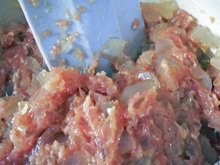 Her. You see, in order to form the dumplings, the dough had to be "stiff", to the point it was really difficult for Her to roll out.
Her. You see, in order to form the dumplings, the dough had to be "stiff", to the point it was really difficult for Her to roll out.
When we had enough, I started steaming them.
I thought they looked great, and they also stood up to the heat well.
So what did we learn? Well first of all, I never thought I’d ever say this, but there was too much soup, so we need to adjust the ratio. Also, I don’t think we needed as much Agar, there was enough gelatin in the pig’s feet, we would only need about maybe 1/2 tsp. The Missus was disappointed in her inability to get the dough thin enough, and I felt for her; the dough was so "stiff" and hard to roll out. We’ll work out the kinks in the future. She thought the dough was much too thick, so maybe this is where we get a pasta maker……
I still managed to eat 2 dozen. The filling was tasty. And we had alot of fun making this.
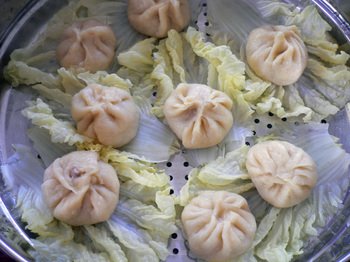
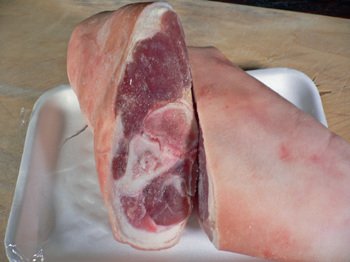
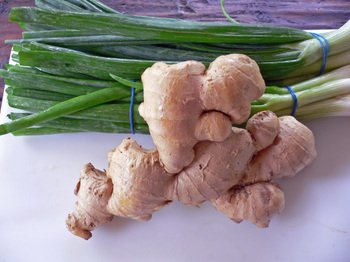

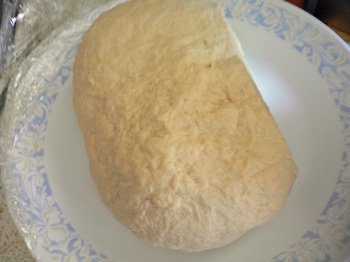
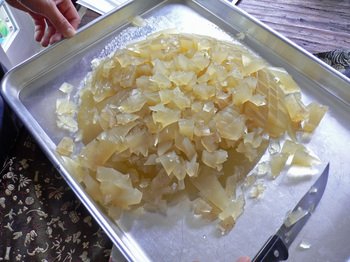
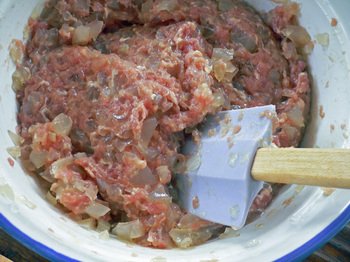
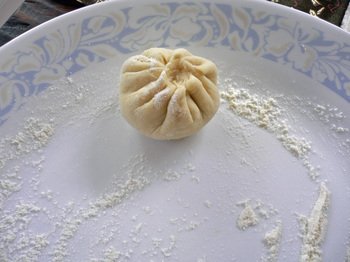
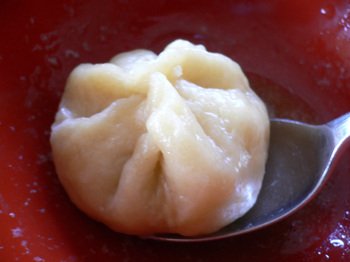
ooh!!! First to comment 🙂 YAY
I am so very impressed!!!
They look wonderful! There is nothing like homemade to make food taste good mmmm I want some now!
BTW I think your missus did a fab job!
If you get enough gelatine into the aspic I don’t think you would need any agar, but it will definately make sure that it sets!
Hi Clare – Based on the recipe in Chinese we weren’t really sure – but I think the trotters just need a bit of “help”. And yes, the Missus did a gradn job!
LOL I think we did that simultneous commenting thing.
You could always try and set the broth and then if it hasn’t set warm it up and add some agar, as long as you take it back up over the critical 44c? (something like that) (I am sure Milly will know)
the advantage is that the agar part doesn’t need to be as cold as the gelatin part to set. Perhaps they are worried that all gelatin will melt in China when it is hot? or in a hot kitchen???
WHOA!! Super-cool that you actually made shao loeng baos, and they look great! There are several things that my Mom told me that you should never make at home, just because of the sheer amount of labor and effort involved. Shao loeng baos are one of those items my Mom warned me against. You and the Missus really expended a lot of effort on those little meat pockets. I’m glad that the results were worthy, and that you learned how to improve in the future. Hey, my motto is, try and try again, and eat the failures! Plus, the dumplings were tasty enough that you wolfed down dozens of em’, and therefore, they were a success in my book!
Neato! I’ve never knew anyone who has attempted to make xiao long bao – congrats! And they came out so cute 🙂 The Missus certaintly has a way with “twisting” the dough, it looks so professional. Success by all standards!! Now if only I could have had a piece or two…hehe
You are brave! I’ve got a similar recipe from my Saveur magazine and thought it was way too involved to make. My hats off to you Kirk! 🙂
Remind me to send you my recipe for Hot and Sour Soup.
Hi kirk, Congrats to you and the your wife for doing a great job. Looks ono.
Regarding the dough…I use a food processor and it whips up in mins. I then roll it out with a pasta roller,so fast and easy.
My recipe is 2cups of bread flour, 2 eggs ,1tsp. salt and water (aprox 1/2cup) more or less dep on text.I like the smooth texture you get from the eggs.
You cant beat using a pasta roller! the sheets can be as thin as paper and transparent.
aloha
Bravo Kirk and the Missus! These look great. The closest I come to making xiao long bao at home is steaming the frozen ones from 99 Ranch.
I feel for your wife though – there’s a tourist restaurant in Shanghai where you can watch hundreds of bao being made and it looks so tiring! I especially feel for the people that have to “de-crab” the tiny hairy crabs just to use their roe in the dumplings.
Wow!
I am saving this, and maybe try it some time in the future! I feel for your Missus, but tell her she did a gorgeous job. I think i need to come over and learn how to fold them, so nicely. I can do mandu, but the round dumplings seem harder for me.
I bet they tasted really delicious, and a lot better than most restaurants. I was surprised there was too much soup. I need to get away I am hungry!
Wow, this looked like quite an undertaking! And the results look beautiful. Next time I’m sure you’ll be able to get it perfect.
The too much soup comment made me think of the first time I saw my cousin eat xiao long bao. I always try to eat it in one big bite so that none of the soup spills out. After all, it’s what makes it so unique. My cousin would bite a hole in the side of the dumpling and discard the soup onto his plate. I felt as thought I had been punched in the gut!
Hi Clare – We did like how the aspic “set”, so I think we’ll just lower the amount of Agar, next time.
Hi PE – Always so positive! The skins were too thick for the Missus, so we’ll have to come up with something to solve that. There were quite a few steps involved in making this.
Hi Kathy – Unfortunately, the dough was not up to the Missus’s standards.
Hi Jean – Consider yourself reminded!
Hi shar – So you’ve made Xiao Long Bao? They are very different from Jiaozi – the dough has to be much stiffer. Also, for Jiaozi, the middle of the dough for each dumpling has to be thicker then the edges which are folded – this is why most good Chinese Dumpling Houses still roll out their dough by hand. Almost sounds like you’re making pasta dough.
Hi Candice – Hope the new “gig” is going well. I really felt bad for Her, the dough was very stiff.
Hi Mills – Thanks much!
Hi Howie – Oh my, that’s heresy, letting the “soup” from the soup dumplings escape!
Holy xiao long bao Batman! I didn’t even realize that’s how the soup gets in there…agar-agar cubes! I’ve always thought, naively I might add, that someone went around and stuck a syringe full of broth into each dumpling before steaming!
Hi Elmo – Well great minds think alike….I think. I thought the same as you until I read the pictorial a few months ago! It was one of those; ooohhh, that’s how they do it moments!
Excellent post
But I’ve noticed that you don’t have a recipe category…please make one.
This is absolutely the kind of impossible exotic thing I am always wanting to try when I have some time on the weekends. No matter how it turns out it’s always an adventure…the shopping, the preparing, the waiting, the cooking, the tasting, the photography, and then the eating and the posting.
Lots of work and lots of fun.
More please,
Emily
Hi Emily – Ok, it’s done – took I bit longer then I thought, but there is now a recipe category.
Those are beautiful, Kirk! You and the Missus really took on a project, and while they are not perfect (I know how dissapointing it can be to have dough come out rolled too thick–my first jaozi were like that) they are still lovely.
Did you really not know about the aspic? Silly boy! 😉
Hi Barbara – I really didn’t know about the aspic, until I saw (the Missus had to read) the recipe last year. It was one of those, “ooohhh that’s how they do it” moments. Also, since Xiao Long Bao is a Shanghainese style dumpling, the Missus and her Mom(from Shandong) really didn’t know how the filling was made. And we never thought to ask relatives……..
What a great job!!!!! How exciting to take on such a tremendous task. And what a great accomplishment!!!! Congrats to you and the Missus!!!! WOW!!!!! Thanks for sharing………..
Hi lance – Oh geez, it wasn’t that big a deal! Thanks though!
Kirk…you guys rock! But of course, what you might need next time is an outsider’s opinion on the quality of the dumplings. Probably a couple dozen should suffice! 🙂
Hi Jack – After working so hard, I think you’ll have to convince the Missus to try these again.
Thanks Kirk! These look positively awesome. I haven’t done detail analysis yet… for obvious reasons on my end. The dough is particularly interesting to me. I’m surprised that you say the xiao long bao dough should be stiffer than other dough types. I would have thought that it would be more “bread” like AND that it would be thicker all the way around. I have seen one method of “rolling” the wrapper that consisted of “scrapping” the dough into a circle using a sharp knife. I imagine that would leave a thicker center with paper thin edges as you described in one of your comments. I’m looking forward to having a kitchen to try these in myself. Maybe have a dumpling party…
Hi Jo – I think that the dough needs to be thin enough for textural purposes, but stiff enough so it won’t burst when handling or steaming, and letting all those precious juices get everywhere but the designated recepticle….you mouth!
Well, I definately need to experiment. I’m not totally dumpling destitute yet. But then I don’t aspire to that state either. I wish I’d had the time to eat them a couple more times. I have plenty of folks to “tease” with real Asian dumplings round here. Even my steam/fried dumplings will be wildly exotic compared to what they typically serve.
Meet Jo – The Mandoo/Jiazhi Queen of North Carolina!!!!
::roaring with laughter:: Hey, why eat steak when you can get dumplings by the dozen?!?!
Hi Kirk,
I found your blog when I was looking around for xiao loong pau recipes. Must commend you and the missus on making these little dumplings as they are hard work! 🙂
I was looking at your steps, and got curious if it was soupy inside the dumpling after it was cooked? I thought maybe it would work better if the aspic were not chopped but put with the filling in chunks? Gonna try making some myself, can’t wait! And thanks for sharing the recipe 🙂
Hi Elaine – We had a nice 50-50 ratio of soup to meat, and it tasted better than many of the XLB(and we’ve had many)we’ve had. If you look closely at the mixture, you’ll notice that pretty large cubes of aspic were used. The source recipe is from the PRC – you can find it here:
http://eatingchinese.org/xlbtutor/xlbtutor.html
Hi there! Great looking recipe.. You didn’t say what the ginger-scallion water is for though . . .
Hi Kimi – “1 – Combine Ground Pork, Pepper, Salt and Sugar (twice the amount of sugar then salt), and Soy Sauce.
2 – Stir Pork mixture in one direction while adding Ginger Scallion water until the filling is saturated and achieves a “pasty” texture.” It’s for addtional flavor and to add moisture.
i just wanted to say that this posting was instrumental in achieving my culinary dream to conquer the this perfect trifecta of meat, soup, peel.
I ended up starting a blog because I thought that i finally had to contribute to society by writing a lengthy exposition on these dumplings. thanks for all the help.
and if you get a chance, check them out! http://kitchensidecar.blogspot.com/2008/11/xiolngbo-shanghai-dumplings-soup.html
Hi Katie – You did a fabulous job….beautiful!
The Flying South Dumpling House in Old Town Shanghai makes the best Xia Long Bao I have ever tasted. Since I live in east Texas and know that I will NEVER find such a treat, I look forward to making and enjoying yours. THANK YOU SO MUCH!!
Hi Bob – Good luck and let me know they turn out.
why must use Agar agar? does this means to makes the fillings taste better? any special reason? Kindly advise. thanks.
Hi Pauline – You don’t need to use agar, we used it so the aspic would set-up a bit better, but I don’t think I’d use it if I made this today. I’d just try to get as gelatin as I could out of the pork hock.
i love xiao long pao! 😀 it was the best in causeway restaurant here. hihi
glad you knew how to make it!! cool i wish i can make it myself too…
Great recipie thanks! turned out perfect!
Hi Er – I’m glad it turned out well for you!
Bookmarking this! Has there been any other attempts? The recipe that I found used homemade pork broth boiled with bones to get it to turn into gelatin. Our dough ended up too thick and I think we needed more soup, although the flavor was good and it ‘gelatinized’ sufficiently. Still a fun project though I’ve been trying to solve the problem of not having great Chinese food in SD by attempting to make things at home….Its hit or miss but usually it takes a couple tries to kind of get it close to what you want. I’m working on Shanghai style zongzi for now but want to try the XLB again!
Yeah, we did this a couple more times. The filling is the easy part to me. Getting the dough right was tough. Also, making that aspic and the ginger scallion water is key. Have fun!